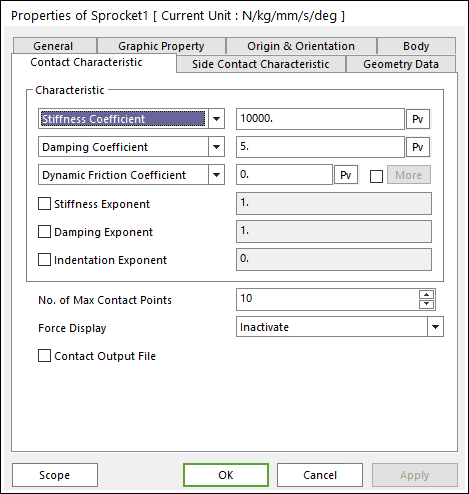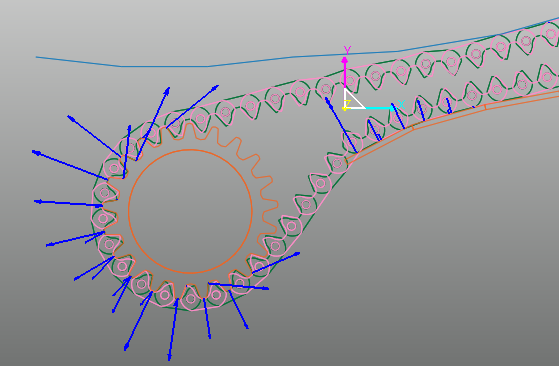
This page defines characteristic values to contact between two geometry entities. Roller, Roller Sprocket, Silent Sprocket, Multiplex Sprocket, Guide, Group Guide Arc, and Lateral Guard supported in RecurDyn are using this page.

Figure 1 Sprocket property page [Contact Characteristic page]
Contact Normal Force
The contact normal force is obtained by

where, k and c are the stiffness and damping
coefficients which are determined by an experimental method, respectively.  and
and  are a penetration and
time differentiation of the penetration, respectively. The exponents
are a penetration and
time differentiation of the penetration, respectively. The exponents  and
and  generates a non-linear contact
force and the exponent
generates a non-linear contact
force and the exponent  yields an indentation damping effect.
yields an indentation damping effect.
•Characteristic: Defines the contact properties such as the stiffness coefficient, damping coefficient, and friction coefficients. Also, these coefficients can be given as user-defined spline curves.
•Stiffness Coefficient: Specifies a stiffness coefficient for the contact normal force.
•Stiffness Spline: The spline shows the contact normal force for the penetration. For more information, click here.
•Damping Coefficient: Specifies a damping coefficient for the contact normal force.
•Damping Spline: The spline shows the contact normal force for the velocity of penetration. For more information, click here.
•Dynamic Friction Coefficient: Specifies a dynamic friction coefficient for the contact friction force. It has three options.
o Dynamic Friction Coefficient: The constant friction coefficient is applied.
o Friction Force Spline: The spline shows the fiction force for the relative velocity. It is recommended to use the spline that x and y values are defined as positive.
o Friction Coefficient Spline: The spline shows the friction coefficient for the relative velocity.
•More: Specifies some friction coefficients for the contact friction force. Refer to Friction.
•Stiffness and Damping Exponent: Generates a non-linear contact normal force.
•Indentation Exponent: Yields an indentation damping effect. When the penetration is very small, the contact force may be negative due to a negative damping force, which is not realistic. This situation can be overcome by using the indentation exponent greater than one.
•No. of Max Contact Point: Defines the number of max contact point for output. User can define this value from 0 to 1000. This value only affects Force Display and RPLT data about contact points.
•Force Display: Graphically displays the all contact force vectors (the sum of the normal and tangential contact force) at each contact point up to the “No. of Max Contact Point” as shown in the below figure. The contact force display vectors about internal 2D contact logic will be graphically showed on center plane of base entities (Sprocket, Guide).

Figure 2 Example of Contact Force Display
•Contact Output File: When this function is checked, RecurDyn creates the contact output file for contact information between sprocket and chain links as follows. (Please refer to this option only output the results for chain links, they checked at output tap in assembly information). The name of output file will be 'ModelName_bodyName.out'.
|
Col. |
Variables |
Descriptions |
|
1 |
Time (sec) |
Simulation Time |
|
2 |
amount of contact point |
Total number of calculated contact points |
|
3 |
Pos_TX of Sprocket CM |
Position X of sprocket’s center marker |
|
4 |
Pos_TY of Sprocket CM |
Position Y of sprocket’s center marker |
|
5 |
Pos_TZ of Sprocket CM |
Position Z of sprocket’s center marker |
|
6 |
Pos_PSI of Sprocket CM |
Orientation Psi of sprocket’s center marker |
|
7 |
Pos_THETA of Sprocket CM |
Orientation Theta of sprocket’s center marker |
|
8 |
Pos_PHI of Sprocket CM |
Orientation Phi of sprocket’s center marker |
|
9 |
|
The index of contact points |
|
10 |
Chain Link ID |
Contacted chain link’s ID |
|
11 |
Pos_TX of Chain Link CM |
Position X of contacted chain link’s center marker |
|
12 |
Pos_TY of Chain Link CM |
Position Y of contacted chain link’s center marker |
|
13 |
Pos_TZ of Chain Link CM |
Position Z of contacted chain link’s center marker |
|
14 |
Pos_PSI of Chain Link CM |
Orientation Psi of contacted chain link’s center marker |
|
15 |
Pos_THETA of Chain Link CM |
Orientation Theta of contacted chain link’s center marker |
|
16 |
Pos_PHI of Chain Link CM |
Orientation Phi of contacted chain link’s center marker |
|
17 |
Global contact position |
Global contact position |
|
18 |
Contact position based on Sprocket |
Contact position based on Sprocket |
|
19 |
Contact position base on Chain Link |
Contact position base on Chain Link |
|
20 |
Contact force based on Sprocket |
Contact force based on Sprocket |
|
21 |
Friction force based on Sprocket |
Friction force based on Sprocket |
|
22 |
Contact force based on Chain Link |
Contact force based on Chain Link |
|
23 |
Friction force based on Chain Link |
Friction force based on Chain Link |